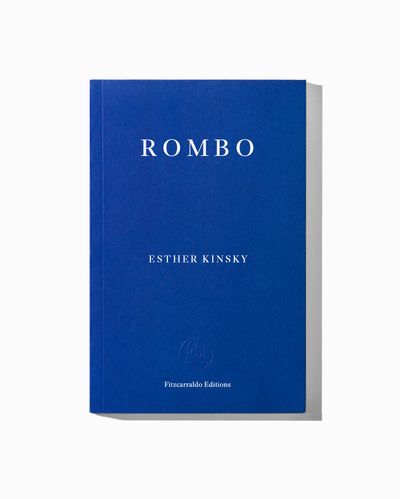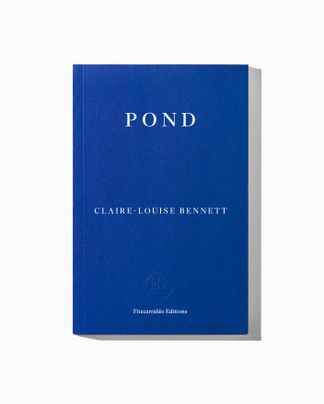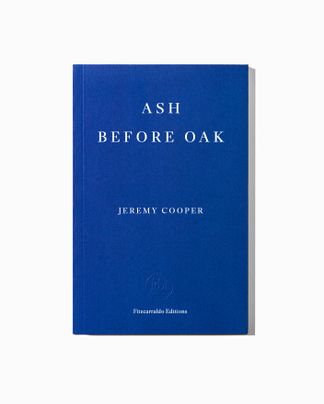In May and September 1976, two earthquakes ripped through north-eastern Italy, causing severe damage to the landscape and its population. About a thousand people died under the rubble, tens of thousands were left without shelter, and many ended up leaving their homes in Friuli forever.
The displacement of material as a result of the earthquakes was enormous. New terrain was formed that reflects the force of the catastrophe and captures the fundamentals of natural history. But it is far more difficult to find expression for the human trauma, the experience of an abruptly shattered existence.
In Rombo, Esther Kinsky’s sublime new novel, seven inhabitants of a remote mountain village talk about their lives, which have been deeply impacted by the earthquake that has left marks they are slowly learning to name. From the shared experience of fear and loss, the threads of individual memory soon unravel and become haunting and moving narratives of a deep trauma.

Rombo
Translated by Caroline Schmidt
French paperback with flaps, 232 pages
Published 5 October 2022
Rombo
Translated by Caroline Schmidt
LANDSCAPE
All around: a dwindling moraine landscape. Soft hills, fields, peat moss bogs in outlying depressions, karst protuberances with oak groves, chestnut trees, blades of grass sharp and thin, growing on ridges less mountainous than they appear, which nevertheless offer a view: over the hill country, the crests dotted with churches and villages, here and there a castle-like ruin that is in reality a mouldering vestige of the First World War. For its mellifluousness the landscape has a tremendous material shift to thank; glaciers, boulders, matter that it carried all the way here with an inevitable clamour that far exceeded the rumble of a rombo. Not a preluding roar, as it was referred to, two hundred years ago, but rather an ongoing rage that no human ear could have endured.
To the south the hills surrender to flatland, to the magnitude of the sky, the openness of the sea. Giant cornfields, industrial strips, highways, gravel quarries at the rivers emptying into the Adriatic Sea. Piave, Tagliamento, Isonzo, each river carrying off its part of the Alps, dolomite metamorphic rocks, pre-alpine conglomerates, the Isonzo’s karstic limestone, whose dazzling white colour people still attribute to the many bones of the soldiers fallen in the Battles of Isonzo. On clear days one can see from the hillcrests all the way to the sea, to the Grado Lagoon with dabs of island bushes, to the chiselled hotels of resort towns, like sharp, uneven teeth on the horizon.
The river that defines this hilly region is the Tagliamento. A wild river, as they say. Yet, aside from the few weeks of high water from snow melt and torrential downpours, the wild thing about it is rather the emptiness, the vastness of the unregulated stone bed, the caprice of the sparse rivulets, always seeking out new paths and courses. At the point where it exits the mountains and enters the moraine landscape, the river changes course, abandoning its eastward path and veering south, taking along with it the Fella from the north – hesitantly, both wavering, turquoise and white; a wavering that produced a giant triangular field of pebbles and scree, which separates the Carnic Alps from the Julian Alps, a bright plane like a wound, a space of procrastination before a backdrop of mountain valleys, before the secluded zones with their own languages, dulled by waning use, their own shrill, helpless songs and tricky dances.
The cemeteries of the hill country villages all have their own small, secluded summits with little churches and a view to the north, to the mountains, the trench of the Tagliamento valley, the narrow passage of the Fella valley, which the Romans passed through, heading north, and the Celts, heading south. To the northwest lie the Carnic Alps, cleft peaks behind pre-Alpine mountain chains, a picture book of the violence that certainly transpired in order for these mountains to be formed. The picture book is located precisely at the unstable point where two lithospheric plates collide, uneasy about their positions. Their discontent radiates eastward, into the mountain valleys of Italia Slava and the mellifluous hill country north of the coastal strip.
To the northeast one’s gaze is met by the Julian Alps and the Alps, the defensive wall of Monte Musi, appearing grey, blue, violet or orange, depending on the light and clarity. The cliffs are sheer in any light: a dark barrier, unclimbable, insurmountable, at the eastern end a mountain peak arching over it, that is, Monte Canin, white from chalk or snow, the dull eye tooth, the border tooth of the valley behind.
Two zones meet before the mountains, continental and Mediterranean climates, the winds, precipitations and temperatures of two migratory fields, to the land and to the sea. Thunderstorms, gales, deluges, earthquakes that all tirelessly abrade the traces of human migration running through this region that – no matter how worn down they may become – still never allow themselves to be erased. The sky falls into a dark mood, the rombo is never far away.
QUAKE
The earthquake is everywhere. In the rubble of collapsed houses overgrown by ivy on Statale 13, in the cracks and scars on the large buildings, in the shattered gravestones, in the crookedness of reconstructed cathedrals, in the empty lanes of the old villages, interconnected like honeycomb, in the ugly new houses and developments modelled on the dream location of suburbia found in American television series. The new houses stand out in the open on the field, at a distance from the rattled towns, often with only a single story – here the main point being to minimize the material that might fall on one’s head, in case once again there is… as there was that year, the earthquake year of 1976. Now it’s half a lifetime ago or more, but the script it inscribed in everyone’s memories has not faded: it is forever being notched anew by the act of recollection, by speaking of all the wheres and hows, of searching for shelter and the fear and listening out for further rumblings – in garages, in the open air, squeezed into the family Fiat, buried beneath rubble, among the dead, a cat in one’s arm. If one laid them out, all these evoked images would stretch from here, the cemetery with a view to the north, all the way to the harshly hatched line of Monte Musi, purple-blue in the distance, more a peak-of-muzzle-and-snout than a mountain of muses, jags around the muzzle for the eye tooth Monte Canin. Everything spelled in the language of the mountains. Perhaps at the end there would be an unexpected trail leading up to its ridge, from where one could look down onto the valley at the foot of Monte Canin, a small river valley which would form a right angle with the path of evoked images from the earthquake. One would hope for doldrums on such a day in order to read the images, for a celebratory calm to walk in along the path of images.
But today it is windy. Right by the wall with a view to the mountains that look as if folded together in this light without shadow, beside a grave sealed by a layer of cement smooth and white with a faded wreath of plastic flowers on it, stands a short man with white hair and bad teeth, talking into his phone. He is describing the grave, emphasizing that it is clean and orderly, and he slowly pronounces the name on it, even mentioning the wreath – on the fadedness of the flowers, however, he does not comment – and in conclusion, as if responding to the voice at the other end of the line, he says: Memory is an animal, it barks with many mouths.
ANSELMO
The short man with white hair and bad teeth is named Anselmo. He is a council worker who always requests work at the cemetery. There is a lot to do there the layer of dirt, covering the mound of rock is thin, and the number of graves limited. The columbaria have to be expanded, graves need to be levelled, remains brought into the ossuary, trees pruned and cut down, the stability of the grave plaques and stones tested. Anselmo knows his way around. He is familiar with the locations where the graves are sinking, knows what kind of damage gravestones can incur and which cemetery plot would be safest in case of an earthquake. He advises against mausoleums, pointing to the cracks in the walls of the showy family burial units. He banters with grave visitors and offers himself up as a confidant to bereaved persons visiting from out of town.
The cemetery is a recommended stop for hikers and cyclists passing through: on the northwest side of the wall there is a long panorama board where one can read the name of every peak. There the semicircle formed by the peaks and crests, surrounding the moraine landscape as if holding it in a rescuing embrace – on the west, north, and east – stretches out like a straight chain before the beholder, who first has to get used to the distortion of the landscape, letting their gaze wander back and forth between the image and the mountain range, while they graze with their fingertips the peaks on the panorama board, as if they could thus feel their constitution. Anselmo is wont to approach these day-trippers, as well, and tell them about the landscape. He always directs their gaze to Monte Canin and its summit, covered in snow into spring, and mentions that he grew up in the shadow of this mountain. When the peak is hidden behind clouds, Anselmo says: It doesn’t want to show itself today. A moody one, that Canin.
6 MAY
On the morning of 6 May a rosy light falls on the snow clinging to Monte Canin’s peak. It soon fades, the sun lies low. The slopes are quiet in the valley on this morning in early May, chalk white and green from beeches and hazelnut bushes, metallic grey from silverberry at the riverside. Beneath thin clouds the heat disperses.
(…)
‘In Kinsky’s novel, the land speaks … Kinsky expertly animates the natural world around her while removing her human hand. Kinsky lets nature uphold its own intractable logic.… If trauma is the inability to redescribe, Rombo offers a powerful antidote in language and the infinite possibilities of description; like the trembling Friulian landscape, forever writing itself anew.’
—Matthew Janney, Financial Times
‘Esther Kinsky has more eyes than most; in her novel Rombo she evokes the entire life of an Italian village before, during, and after the two devastating earthquakes of 1976, but each plant and animal central to the village is also a character, and the most important character of all is the landscape itself. The book becomes as much about the futures as the past, for our natural disasters are increasingly man-made, and we need more than ever this reminder of universal impermanence and the marks of memory we leave in its wake.’
— Mary Ruefle, author of Madness, Rack, and Honey
‘A tragic travelogue to the underworld-turned-world that recasts a newly lost Italian past with a climate-wise chorus straight out of the most harrowing Greek drama.’
— Joshua Cohen, author of The Netanyahus
‘In Esther Kinsky’s new novel, language becomes the highest form of compassion and solidarity – not only with us human beings, but with the whole world, organic, non-organic, speaking out with many mouths and living voices. A miracle of a book; should be shining when it gets dark.’
— Maria Stepanova, author of In Memory of Memory
‘Esther Kinsky has created a literary oeuvre of impressive stylistic brilliance, thematic diversity and stubborn originality…. It is always clear that for her the only landscape worth describing is the one in which she is currently situated. Far from “eco-dreaming”, without sorrow or critique, Kinsky’s novels and poems position humanity in relation to the ruins it has produced and what still remains of nature.’
— 2022 Kleist Prize jury
‘[Kinsky] has a poet’s ear for rhythm and precision, elegantly rendered in Caroline Schmidt’s translation. The author has a great gift for describing landscape; she lingers meticulously over rocks and ridges and the ancient formation of mountains.’
— Charlie Lee, Times Literary Supplement
‘While the narrator offers insights about collective trauma and the transformative impact of nature’s whims on one’s sense of home, the book is filled with the voices of the landscape’s inhabitants.’
— New Yorker
‘Moving testimonies from fictionalised inhabitants of Friuli are interspersed with detailed observations about the landscape, geology, history and folklore of the area, all set down in precise, mellifluous prose.’
— Michael Delgado, i News
‘In Esther Kinsky, German literature has an author whose books are full of poetic intelligence…. A brilliant new novel.’
— Neue Zürcher Zeitung
‘Rombo is staggering. There is something epic about it.… It’s about how we make places habitable – homes, memories, the past – and carry on.’
— Magnus Rena, Review 31
‘Gracefully translated by Caroline Schmidt, Rombo is ambitious in its aim of presenting the total ecosystem of an area: geology, gossip, flora and folktales rub up against each other in an accumulating series of vignettes. Each voice remains distinct, however, in Kinsky’s delicately insistent prose, which draws its reader into the confidence of the village community.… The notion of tales ‘written into the landscape’ underpins a central preoccupation of Kinsky’s intimate and poised novel: what happens when a landscape loses its legibility?’
— Damian Walsh, Literary Review
‘The quality of Esther Kinsky’s writing is so good that you cannot fail to be spellbound by it.’
— The Modern Novel
‘Rombo, vast yet spectral, is framed around spaces where things used to be. Its sonorous lyricism – and the slow, doom-laden beauty of its translation by Caroline Schmidt – intones something beyond the page…. Something reverberates under Kinsky’s calm carousel of artefacts: in the shifting plates, the permanence and then shocking displacement, the violent reordering of the psyche.’
— Imogen Dewey, Meanjin
Praise for Grove
‘What makes Grove so noteworthy is the keening, perfectly weighted clarity of Esther Kinsky’s prose; Caroline Schmidt’s elegantly considered translation is meticulous but never overstated.’
— Lucy Scholes, Financial Times
‘This is a sublime book, born of profound, empathetic understanding.’
— Declan O’Driscoll, Irish Times
Esther Kinsky grew up by the river Rhine and lived in London for twelve years. She is the author of six volumes of poetry, five novels (Summer Resort, Banatsko, River, Grove, Rombo), numerous essays on language, poetry and translation and three children’s books. She has translated many notable English (John Clare, Henry David Thoreau, Iain Sinclair) and Polish (Joanna Bator, Miron Białoszewski, Magdalena Tulli) authors into German. Both River and Grove won numerous literary prizes in Germany. Seeing Further is her fourth book published by Fitzcarraldo Editions.
Caroline Schmidt was born in Princeton. She translated Esther Kinsky’s Grove, and has translated poetry by Friederike Mayröcker, and art historical essays, museum catalogues and exhibition texts for Albertina in Vienna and Pinakothek der Moderne in Munich, among others. She lives in Berlin.





